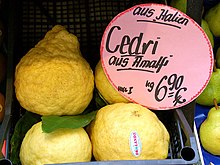Citrus
From Wikipedia, the free encyclopedia
For other uses, see Citrus (disambiguation).

| Citrus | |
|---|---|
| Sweet orange (Citrus × sinensis cultivar) | |
| Scientific classification | |
| Kingdom: | Plantae |
| Division: | Magnoliophyta |
| Class: | Magnoliopsida |
| Subclass: | Rosidae |
| Order: | Sapindales |
| Family: | Rutaceae |
| Subfamily: | Aurantioideae |
| Tribe: | Citreae |
| Genus: | Citrus L. |
| Species and hybrids | |
Important species:
Citrus aurantifolia – Key lime Citrus maxima – Pomelo Citrus medica – Citron Citrus reticulata – Mandarin orange
Important hybrids:
Citrus × aurantium – Bitter orange Citrus × latifolia – Persian lime Citrus × limon – Lemon Citrus × limonia – Rangpur Citrus × paradisi – Grapefruit Citrus × sinensis – Sweet orange Citrus × tangerina – Tangerine See also below for other species and hybrids. | |
| Synonyms | |
Eremocitrus
Microcitrus and see text | |
Citrus is a common term and genus (Citrus) of flowering plants in the rue family, Rutaceae. Citrus is believed to have originated in the part ofSoutheast Asia bordered by Northeast India, Myanmar (Burma) and the Yunnan province of China.[1][2][3] Citrus fruit has been cultivated in an ever-widening area since ancient times; the best-known examples are the oranges, lemons, grapefruit, and limes.
The generic name originated in Latin, where it specifically referred to the plant now known as Citron (C. medica). It was derived from the ancient Greek word for cedar, κέδρος (kédros). Some believe this was because Hellenistic Jews used the fruits of C. medica during Sukkot (Feast of the Tabernacles) in place of a cedar cone,[4] while others state it was due to similarities in the smell of citrus leaves and fruit with that of cedar.[5]Collectively, Citrus fruits and plants are also known by the Romance loanword agrumes (literally "sour fruits").
The taxonomy and systematics of the genus are complex and the precise number of natural species is unclear, as many of the named species arehybrids clonally propagated through seeds (by apomixis), and there is genetic evidence that even some wild, true-breeding species are of hybrid origin.[6] Cultivated Citrus may be derived from as few as four ancestral species. Natural and cultivated origin hybrids include commercially importantfruit such as the oranges, grapefruit, lemons, some limes, and some tangerines.
Research suggests that the closely related genus Fortunella (kumquats), and perhaps also Poncirus and the Australian Microcitrus and Eremocitrus, should be included in Citrus; most botanists now classify Microcitrus and Eremocitrus as part of the genus Citrus.[7] Two additional genera: Triphasiaand Clymenia are likewise very closely related, and bear hesperidium fruits, but are not considered part of the Citrus genus. At least one, Clymenia, will hybridize with kumquats and some limes.
Uses
[edit]Culinary
Many citrus fruits, such as oranges, tangerines, grapefruits, and clementines, are generally eaten fresh. They are typically peeled and can be easily split into segments. Grapefruit is more commonly halved and eaten out of the skin with a spoon.[15] There are special spoons (grapefruit spoons) with serrated tips designed for this purpose. Orange and grapefruit juices are also very popular breakfast beverages. More acidic citrus, such as lemons andlimes, are generally not eaten on their own. Meyer Lemons can be eaten 'out of hand' with the fragant skin; they are both sweet and sour. Lemonade orlimeade are popular beverages prepared by diluting the juices of these fruits and adding sugar. Lemons and limes are also used as garnishes or in cooked dishes. Their juice is used as an ingredient in a variety of dishes; it can commonly be found in salad dressings and squeezed over cooked meat or vegetables. A variety of flavours can be derived from different parts and treatments of citrus fruits. The rind and oil of the fruit is generally very bitter, especially when cooked, and so is often combined with sugar. The fruit pulp can vary from sweet and tart to extremely sour. Marmalade, a condiment derived from cooked orange and lemon, can be especially bitter, but is usually sweetened to cut the bitterness and produce a jam-like result. Lemon or lime is commonly used as a garnish for water, soft drinks, or cocktails. Citrus juices, rinds, or slices are used in a variety of mixed drinks. The colourful outer skin of some citrus fruits, known as zest, is used as a flavouring in cooking; the white inner portion of the peel, the pith, is usually avoided due to its bitterness. The zest of a citrus fruit, typically lemon or an orange, can also be soaked in water in a coffee filter, and drunk.
[edit]Medical
Citrus juice also has medical uses; lemon juice is used to relieve the pain of bee stings.[citation needed] Oranges were historically used for their high content of vitamin C, which prevents scurvy. Scurvy is caused by vitamin C deficiency, and can be prevented by having 10 milligrams of vitamin C a day. An early sign of scurvy is fatigue. If ignored, later symptoms are bleeding and bruising easily. British sailors were given a ration of citrus fruits on long voyages to prevent the onset of scurvy, hence the British nickname of Limey.
Pectin is a structural heteropolysaccharide contained in the primary cell walls of plants. The extract of it from citrus fruits is used in medicine such as Tylenol for the gelling effect of it when broken down.[citation needed] Limes and lemons as well as oranges and grapefruits are among the highest in this level.[16]
After consumption, the peel is sometimes used as a facial cleanser. A peel of lemons or orange is commonly used as a means to moisten medical cannabis when stored with it.
Before the development of fermentation-based processes, lemons were the primary commercial source of citric acid.
Citrus fruit juices, such as orange, lime and lemon, may be useful for lowering the risk factors for specific types of kidney stones. Grapefruit is another fruit juice that can be used to lower blood pressure because it interferes with the metabolism of calcium channel blockers.[17] Lemons have the highest concentration of citrate of any citrus fruit, and daily consumption of lemonade has been shown to decrease the rate of stone formation.[18]
Citrus fruits have been observed to be used by Capuchin (Cebus capucinus) monkeys in Costa Rica as topical balms to protect against insects as well as an astringent and anti-fungalagent.[citation needed]
[edit]List of citrus fruits
The genus Citrus has been suggested to originate in Southeast Asia. Prior to human cultivation, it consisted of just a few species, namely:
- Citrus aurantifolia – Key Lime, Omani Lime, from India
- Citrus maxima – Pomelo (pummelo, shaddock), from the Malay Archipelago
- Citrus medica – Citron, from India
- Citrus reticulata – Mandarin orange, from China
- Citrus trifoliata – Trifoliate orange, from Korea and adjacent China (often separated as Poncirus)
- Australian limes
- Citrus australasica – Finger lime (sometimes separated in Microcitrus)
- Citrus australis – Australian round lime (sometimes separated in Microcitrus)
- Citrus glauca – Desert Lime (sometimes separated in Eremocitrus)
- and 3 other Microcitrus
- Kumquats, 4-5 species from East Asia ranging into Southeast Asia (often separated as Fortunella)
- Papedas, including
- Citrus halimii – limau kadangsa, limau kedut kera, from Thailand and Malaya
- Citrus indica – Indian wild orange, from the Indian subcontinent[19]
- Citrus macroptera from Indochina and Melanesia[19]
- "Khasi Papeda" – Citrus latipes from Assam, Meghalaya, Burma[19]
[edit]Hybrids and cultivars
Sorted by parentage. As each is the product of (at least) two parent species, they are listed multiple times.
Citrus maxima-based
- Amanatsu, natsumikan – Citrus ×natsudaidai (C. maxima × unknown)
- Cam sành – (C. reticulata × C. ×sinensis)
- Grapefruit – Citrus ×paradisi (C. maxima × C. ×sinensis)
- Imperial lemon – (C. ×limon × C. ×paradisi)
- Kinnow – (C. ×nobilis × C. ×deliciosa)
- Kiyomi – (C. ×sinensis × C. ×unshiu)
- Lemon – (probably C. maxima × C. medica)
- Minneola tangelo – (C. reticulata × C. ×paradisi)
- Orangelo, Chironja – (C. ×paradisi × C. ×sinensis)
- Oroblanco, Sweetie – (C. maxima × C. ×paradisi)
- Sweet orange – Citrus ×sinensis (probably C. maxima × C. reticulata)
- Tangelo – Citrus ×tangelo (C. reticulata × C. maxima or C. ×paradisi)
- Tangor – Citrus ×nobilis (C. reticulata × C. ×sinensis)
- Ugli – (C. reticulata × C. maxima or C. ×paradisi)
Citrus medica-based
- Buddha's hand – Citrus medica var. sarcodactylus
- Citron varieties with sour pulp – Diamante citron, Florentine citron, Greek citron and Balady citron
- Citron varieties with sweet pulp – Corsican citron and Moroccan citron.
- Etrog, a group of citron cultivars (the term originally just means "citrus fruit")
- Fernandina – Citrus ×limonimedica (probably (C. medica × C. maxima) × C. medica)
- Ponderosa lemon – (probably (C. medica × C. maxima) × C. medica)
- Lemon – (probably C. medica × C. maxima)
- Yemenite citron – a pulpless citron.
Citrus reticulata-based
- Bergamot orange – Citrus ×aurantium ssp. bergamia or Citrus ×bergamia
- Bitter orange, Seville Orange – Citrus ×aurantium
- Blood orange – Citrus ×sinensis cultivars
- Calamondin, Calamansi – (Citrus reticulata × Citrus japonica)
- Cam sành – (C. reticulata × C. ×sinensis)
- Chinotto – Citrus ×aurantium var. myrtifolia or Citrus ×myrtifolia
- ChungGyun – Citrus reticulata cultivar[verification needed]
- Clementine – Citrus ×clementina
- Cleopatra Mandarin – Citrus ×reshni
- Siranui – Citrus reticulata cv. 'Dekopon' (ChungGyun × Ponkan)
- Daidai – Citrus ×aurantium var. daidai or Citrus ×daidai
- Grapefruit – Citrus ×paradisi (C. maxima × C. ×sinensis)
- Hermandina – Citrus reticulata cv. 'Hermandina'
- Imperial lemon – ((C. maxima × C. medica) × C. ×paradisi)
- Kinnow, Wilking – (C. ×nobilis × C. ×deliciosa)
- Kiyomi – (C. sinensis × C. ×unshiu)
- Laraha – ''C. ×aurantium ssp. currassuviencis
- Mediterranean mandarin, Willow Leaf – Citrus ×deliciosa
- Meyer lemon, Valley Lemon – Citrus ×meyeri ((C. maxima × C. medica) × C. ×paradisi or C. ×sinensis)
- Michal mandarin – Citrus reticulata cv. 'Michal'
- Mikan, Satsuma – Citrus ×unshiu
- Naartjie – (C. reticulata × C. nobilis)
- Nova mandarin, Clemenvilla
- Orangelo, Chironja – (C. ×paradisi × C. ×sinensis)
- Oroblanco, Sweetie – (C. maxima × C. ×paradisi)
- Ponkan – Citrus reticulata cv. 'Ponkan'
- Rangpur, Lemanderin, Mandarin Lime – Citrus ×limonia ((C. reticulata × C. maxima) × C. medica)
- Sweet orange – Citrus ×sinensis (probably C. maxima × C. reticulata)
- Tangelo – Citrus ×tangelo (C. reticulata × C. maxima or C. ×paradisi)
- Tangerine – Citrus ×tangerina
- Tangor – Citrus ×nobilis (C. reticulata × C. ×sinensis)
- Ugli – (C. reticulata × C. maxima or C. ×paradisi)
- Yuzu – Citrus ×junos (C. reticulata × C. ×ichangensis)
Other/Unresolved
- Alemow, Colo – Citrus ×macrophylla
- Djeruk limau – Citrus ×amblycarpa
- Gajanimma, Carabao Lime – Citrus ×pennivesiculata
- Hyuganatsu, Hyuganatsu pumelo – Citrus tamurana
- Ichang lemon, Ichang Papeda – Citrus ×ichangensis
- Imperial lemon – (C. ×limon × C. ×paradisi)
- Iyokan, anadomikan – Citrus ×iyo
- Kabosu – Citrus ×sphaerocarpa
- Kaffir lime, makrut – Citrus ×hystrix
- Limetta, Sweet Lemon, Sweet Lime, mosambi – Citrus ×limetta
- Palestine sweet lime(fr) – Citrus ×limettioides Tanaka
- Ougonkan – Citrus flaviculpus hort ex.Tanaka
- Persian lime, Tahiti Lime – Citrus ×latifolia
- Pompia – Citrus monstruosa, a nomen nudum
- Rough lemon – Citrus ×jambhiri Lush.
- Sakurajima komikan orange
- Shekwasha, Hirami Lemon, Taiwan Tangerine – Citrus ×depressa
- Shonan gold – (Ougonkan) Citrus flaviculpus hort ex. Tanaka × (Imamura unshiu), Citrus unshiu Marc
- Sudachi – Citrus ×sudachi
- Sunki, Suenkat – Citrus ×sunki
- Tachibana orange – Citrus ×tachibana (Mak.) Tanaka
- Volkamer lemon – Citrus ×volkameriana
For hybrids with kumquats, see ×Citrofortunella. For hybrids with the Trifoliate Orange, see citrange.










No comments:
Post a Comment